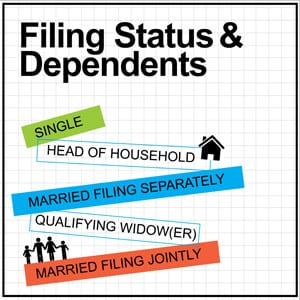
How To Determine Your Filing Status Before Your Tax Preparation Meeting
Your FILING STATUS is used to determine filing requirements, standard deduction, eligibility for certain credits/deductions, and most importantly your correct tax liability for the end of the tax year. It is also an area that may be confusing and misinterpreted and if filed incorrectly, can create an unnecessary burden for you now and in the future.
TAX FACT: Your marital status on the last day of the year determines your marital status for the entire year. If more than one filing status applies to you, choose the one that gives you the lowest tax obligation. If you may qualify as Head of Household, refer to the tax tip specific to this filing status.
The 5 IRS Filing Statuses
- SINGLE – Anyone who is unmarried, divorced or legally separated according to state law.
- MARRIED FILING JOINTLY – Taxpayers are married and both agree to file a joint return. If your spouse died during the year and you did not remarry during the current tax year, you may still file a joint return with that spouse for the year of death. The following year, the surviving spouse may qualify to file as Qualifying Widower or Single.
- MARRIED FILING SEPARATELY – Taxpayers are married but do not agree to file a joint return. In most cases, this filing status will create the largest tax liability due to the limitation of deductions and credits that occur by selecting this status.
- HEAD OF HOUSEHOLD – Taxpayer is unmarried or “considered unmarried” and must have paid more than half the cost of maintaining a home for himself and a qualifying person. Taxpayers claiming this status can benefit from a higher standard deduction and lower tax rates than single taxpayers, however, not every single parent qualifies for the Head of Household status.
TAX TIP- This is a filing status that gets incorrectly classified very often so please refer to Publication 501 Exemptions, Standard Deduction, and Filing Information for more detail.
The IRS has adopted the perspective that “head of household filing status is not a matter simply determined by physical boundaries, but by all the facts of a case.” In other words, just because two families share the same physical address, that does not automatically mean they cannot both be head of household. Instead, taxpayers will need to carefully analyze the actual circumstances for each separate situation.
- QUALIFYING WIDOW(er) WITH DEPENDENT CHILD – Taxpayer is unmarried, his/her spouse died within the last two years, he/she has not remarried, and the taxpayer has cared for a dependent child for the entire year. This filing status entitles the taxpayer to use joint return tax rates and the highest standard deduction amount for the 2 years following the spouses death.
Check out this cool IRS Interactive Tool which can help determine your correct filing status for 2013.

